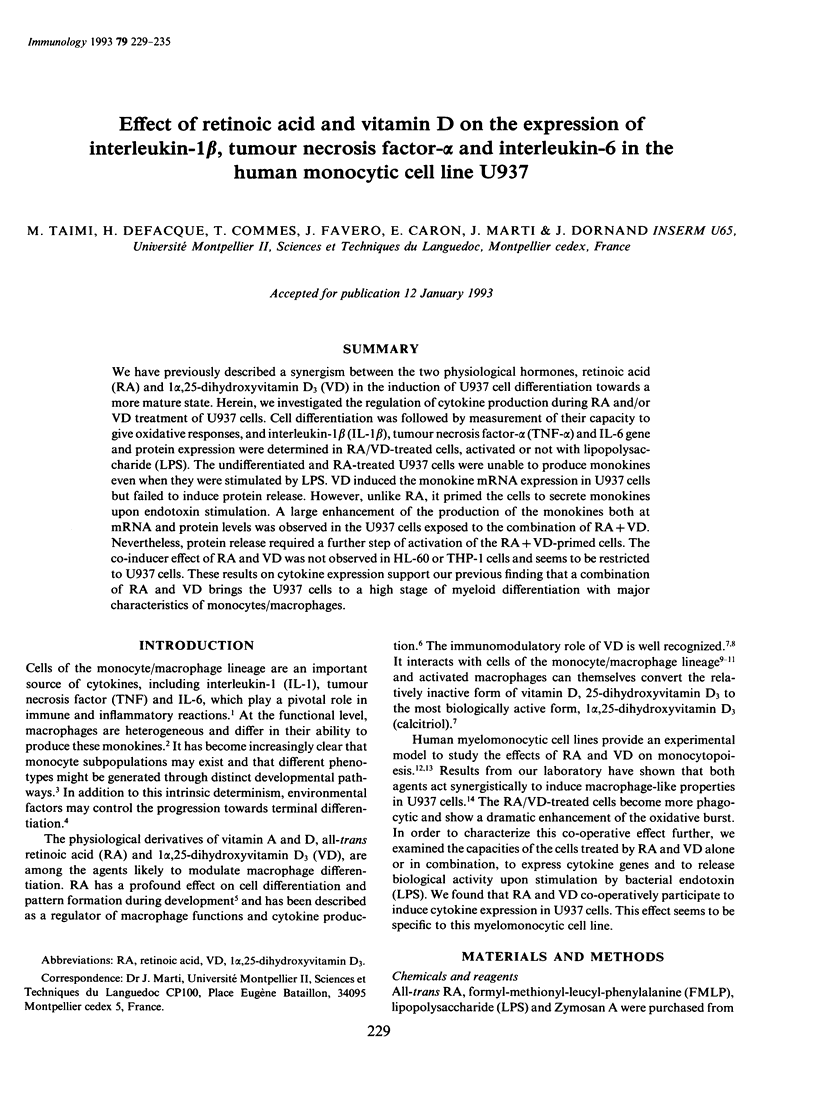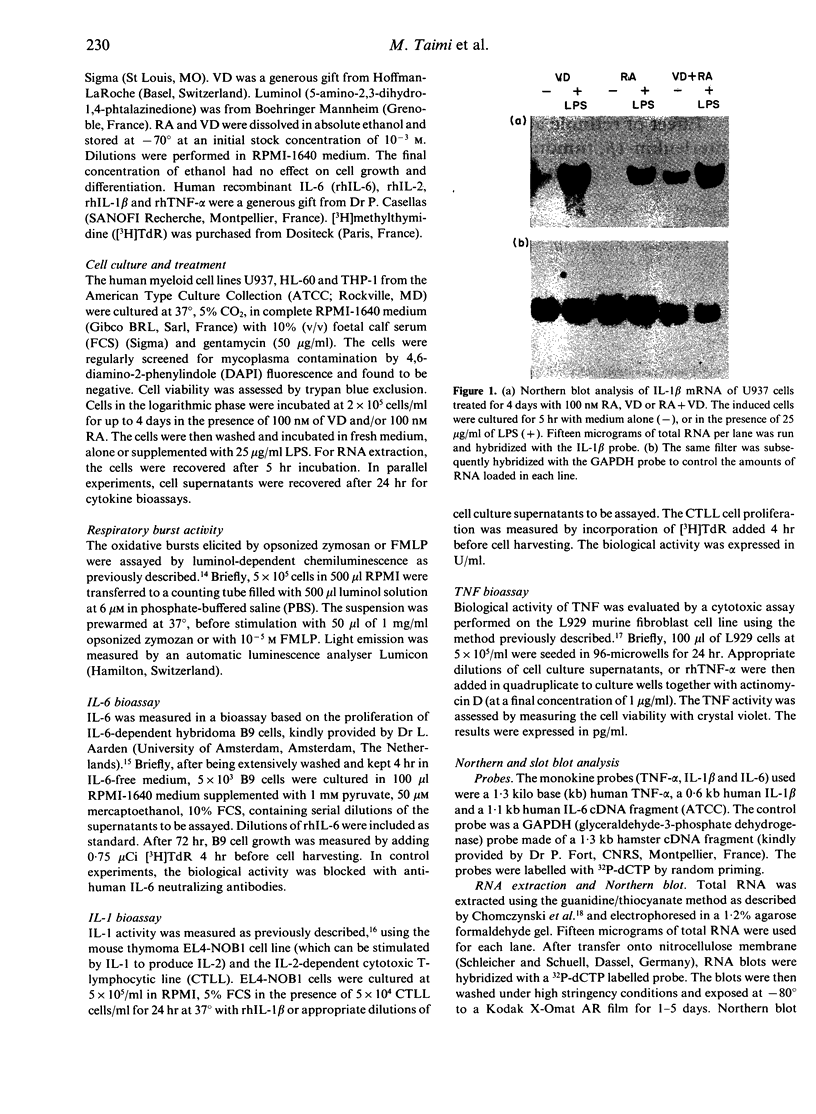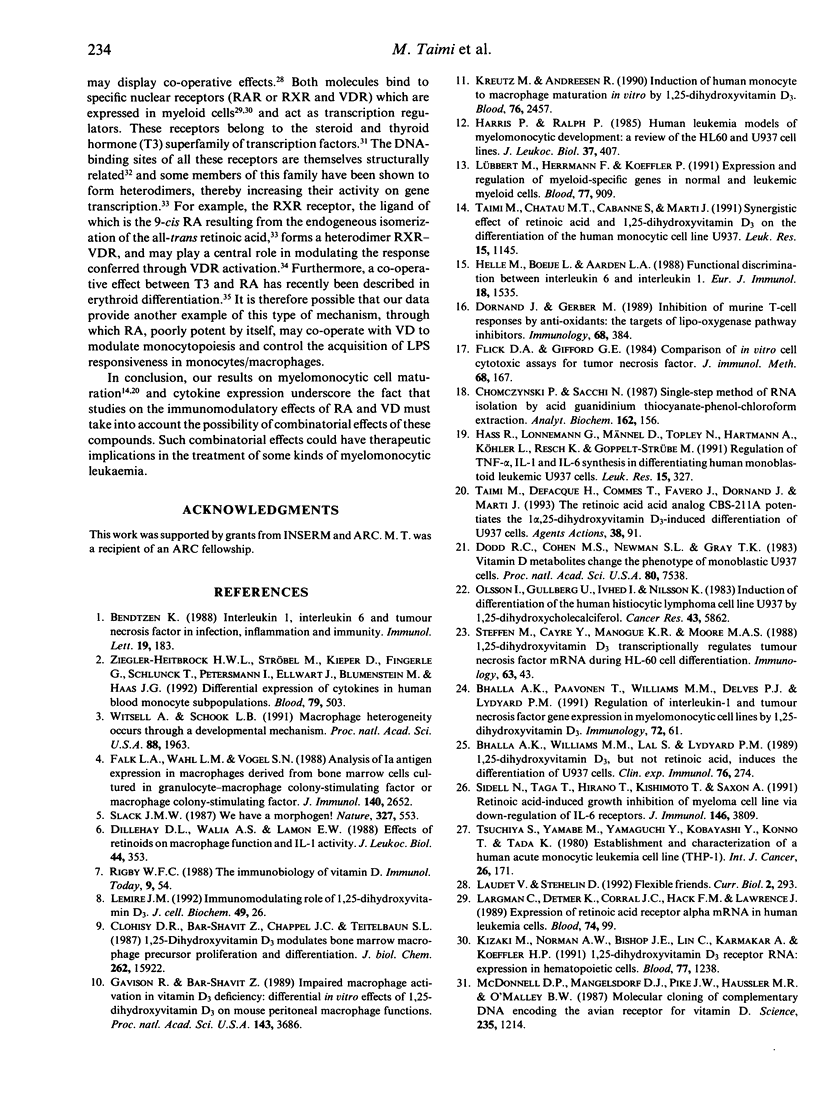Abstract
We have previously described a synergism between the two physiological hormones, retinoic acid (RA) and 1 alpha,25-dihydroxyvitamin D3 (VD) in the induction of U937 cell differentiation towards a more mature state. Herein, we investigated the regulation of cytokine production during RA and/or VD treatment of U937 cells. Cell differentiation was followed by measurement of their capacity to give oxidative responses, and interleukin-1 beta (IL-1 beta), tumour necrosis factor-alpha (TNF-alpha) and IL-6 gene and protein expression were determined in RA/VD-treated cells, activated or not with lipopolysaccharide (LPS). The undifferentiated and RA-treated U937 cells were unable to produce monokines even when they were stimulated by LPS. VD induced the monokine mRNA expression in U937 cells but failed to induce protein release. However, unlike RA, it primed the cells to secrete monokines upon endotoxin stimulation. A large enhancement of the production of the monokines both at mRNA and protein levels was observed in the U937 cells exposed to the combination of RA + VD. Nevertheless, protein release required a further step of activation of the RA + VD-primed cells. The co-inducer effect of RA and VD was not observed in HL-60 or THP-1 cells and seems to be restricted to U937 cells. These results on cytokine expression support our previous finding that a combination of RA and VD brings the U937 cells to a high stage of myeloid differentiation with major characteristics of monocytes/macrophages.
Full text
PDF






Images in this article
Selected References
These references are in PubMed. This may not be the complete list of references from this article.
- Bendtzen K. Interleukin 1, interleukin 6 and tumor necrosis factor in infection, inflammation and immunity. Immunol Lett. 1988 Nov;19(3):183–191. doi: 10.1016/0165-2478(88)90141-1. [DOI] [PubMed] [Google Scholar]
- Bhalla A. K., Paavonen T., Williams M. M., Delves P. J., Lydyard P. M. Regulation of interleukin-1 and tumour necrosis factor gene expression in myelomonocytic cell lines by 1,25-dihydroxyvitamin D3. Immunology. 1991 Jan;72(1):61–64. [PMC free article] [PubMed] [Google Scholar]
- Bhalla A. K., Williams M. M., Lal S., Lydyard P. M. 1,25-Dihydroxyvitamin D3, but not retinoic acid, induces the differentiation of U937 cells. Clin Exp Immunol. 1989 May;76(2):274–277. [PMC free article] [PubMed] [Google Scholar]
- Chomczynski P., Sacchi N. Single-step method of RNA isolation by acid guanidinium thiocyanate-phenol-chloroform extraction. Anal Biochem. 1987 Apr;162(1):156–159. doi: 10.1006/abio.1987.9999. [DOI] [PubMed] [Google Scholar]
- Clohisy D. R., Bar-Shavit Z., Chappel J. C., Teitelbaum S. L. 1,25-Dihydroxyvitamin D3 modulates bone marrow macrophage precursor proliferation and differentiation. Up-regulation of the mannose receptor. J Biol Chem. 1987 Nov 25;262(33):15922–15929. [PubMed] [Google Scholar]
- Dillehay D. L., Walia A. S., Lamon E. W. Effects of retinoids on macrophage function and IL-1 activity. J Leukoc Biol. 1988 Nov;44(5):353–360. doi: 10.1002/jlb.44.5.353. [DOI] [PubMed] [Google Scholar]
- Dodd R. C., Cohen M. S., Newman S. L., Gray T. K. Vitamin D metabolites change the phenotype of monoblastic U937 cells. Proc Natl Acad Sci U S A. 1983 Dec;80(24):7538–7541. doi: 10.1073/pnas.80.24.7538. [DOI] [PMC free article] [PubMed] [Google Scholar]
- Dornand J., Gerber M. Inhibition of murine T-cell responses by anti-oxidants: the targets of lipo-oxygenase pathway inhibitors. Immunology. 1989 Nov;68(3):384–391. [PMC free article] [PubMed] [Google Scholar]
- Falk L. A., Wahl L. M., Vogel S. N. Analysis of Ia antigen expression in macrophages derived from bone marrow cells cultured in granulocyte-macrophage colony-stimulating factor or macrophage colony-stimulating factor. J Immunol. 1988 Apr 15;140(8):2652–2660. [PubMed] [Google Scholar]
- Flick D. A., Gifford G. E. Comparison of in vitro cell cytotoxic assays for tumor necrosis factor. J Immunol Methods. 1984 Mar 30;68(1-2):167–175. doi: 10.1016/0022-1759(84)90147-9. [DOI] [PubMed] [Google Scholar]
- Gavison R., Bar-Shavit Z. Impaired macrophage activation in vitamin D3 deficiency: differential in vitro effects of 1,25-dihydroxyvitamin D3 on mouse peritoneal macrophage functions. J Immunol. 1989 Dec 1;143(11):3686–3690. [PubMed] [Google Scholar]
- Harris P., Ralph P. Human leukemic models of myelomonocytic development: a review of the HL-60 and U937 cell lines. J Leukoc Biol. 1985 Apr;37(4):407–422. doi: 10.1002/jlb.37.4.407. [DOI] [PubMed] [Google Scholar]
- Hass R., Lonnemann G., Männel D., Topley N., Hartmann A., Köhler L., Resch K., Goppelt-Strübe M. Regulation of TNF-alpha, IL-1 and IL-6 synthesis in differentiating human monoblastoid leukemic U937 cells. Leuk Res. 1991;15(5):327–339. doi: 10.1016/0145-2126(91)90008-h. [DOI] [PubMed] [Google Scholar]
- Helle M., Boeije L., Aarden L. A. Functional discrimination between interleukin 6 and interleukin 1. Eur J Immunol. 1988 Oct;18(10):1535–1540. doi: 10.1002/eji.1830181010. [DOI] [PubMed] [Google Scholar]
- Kizaki M., Norman A. W., Bishop J. E., Lin C. W., Karmakar A., Koeffler H. P. 1,25-Dihydroxyvitamin D3 receptor RNA: expression in hematopoietic cells. Blood. 1991 Mar 15;77(6):1238–1247. [PubMed] [Google Scholar]
- Kliewer S. A., Umesono K., Mangelsdorf D. J., Evans R. M. Retinoid X receptor interacts with nuclear receptors in retinoic acid, thyroid hormone and vitamin D3 signalling. Nature. 1992 Jan 30;355(6359):446–449. doi: 10.1038/355446a0. [DOI] [PMC free article] [PubMed] [Google Scholar]
- Kreutz M., Andreesen R. Induction of human monocyte to macrophage maturation in vitro by 1,25-dihydroxyvitamin D3. Blood. 1990 Dec 15;76(12):2457–2461. [PubMed] [Google Scholar]
- Largman C., Detmer K., Corral J. C., Hack F. M., Lawrence H. J. Expression of retinoic acid receptor alpha mRNA in human leukemia cells. Blood. 1989 Jul;74(1):99–102. [PubMed] [Google Scholar]
- Lemire J. M. Immunomodulatory role of 1,25-dihydroxyvitamin D3. J Cell Biochem. 1992 May;49(1):26–31. doi: 10.1002/jcb.240490106. [DOI] [PubMed] [Google Scholar]
- Lübbert M., Herrmann F., Koeffler H. P. Expression and regulation of myeloid-specific genes in normal and leukemic myeloid cells. Blood. 1991 Mar 1;77(5):909–924. [PubMed] [Google Scholar]
- Mangelsdorf D. J., Borgmeyer U., Heyman R. A., Zhou J. Y., Ong E. S., Oro A. E., Kakizuka A., Evans R. M. Characterization of three RXR genes that mediate the action of 9-cis retinoic acid. Genes Dev. 1992 Mar;6(3):329–344. doi: 10.1101/gad.6.3.329. [DOI] [PubMed] [Google Scholar]
- McDonnell D. P., Mangelsdorf D. J., Pike J. W., Haussler M. R., O'Malley B. W. Molecular cloning of complementary DNA encoding the avian receptor for vitamin D. Science. 1987 Mar 6;235(4793):1214–1217. doi: 10.1126/science.3029866. [DOI] [PubMed] [Google Scholar]
- Olsson I., Gullberg U., Ivhed I., Nilsson K. Induction of differentiation of the human histiocytic lymphoma cell line U-937 by 1 alpha,25-dihydroxycholecalciferol. Cancer Res. 1983 Dec;43(12 Pt 1):5862–5867. [PubMed] [Google Scholar]
- Rigby W. F. The immunobiology of vitamin D. Immunol Today. 1988 Feb;9(2):54–58. [PubMed] [Google Scholar]
- Schroeder C., Gibson L., Zenke M., Beug H. Modulation of normal erythroid differentiation by the endogenous thyroid hormone and retinoic acid receptors: a possible target for v-erbA oncogene action. Oncogene. 1992 Feb;7(2):217–227. [PubMed] [Google Scholar]
- Sidell N., Taga T., Hirano T., Kishimoto T., Saxon A. Retinoic acid-induced growth inhibition of a human myeloma cell line via down-regulation of IL-6 receptors. J Immunol. 1991 Jun 1;146(11):3809–3814. [PubMed] [Google Scholar]
- Slack J. M. Embryology: we have a morphogen! Nature. 1987 Jun 18;327(6123):553–554. doi: 10.1038/327553a0. [DOI] [PubMed] [Google Scholar]
- Steffen M., Cayre Y., Manogue K. R., Moore M. A. 1,25-Dihydroxyvitamin D3 transcriptionally regulates tumour necrosis factor mRNA during HL-60 cell differentiation. Immunology. 1988 Jan;63(1):43–46. [PMC free article] [PubMed] [Google Scholar]
- Taimi M., Chateau M. T., Cabane S., Marti J. Synergistic effect of retinoic acid and 1,25-dihydroxyvitamin D3 on the differentiation of the human monocytic cell line U937. Leuk Res. 1991;15(12):1145–1152. doi: 10.1016/0145-2126(91)90183-t. [DOI] [PubMed] [Google Scholar]
- Taimi M., Defacque H., Commes T., Favero J., Dornand J., Marti J. The retinoic acid analog CBS-211A potentiates the 1 alpha,25-dihydroxyvitamin D3-induced differentiation of U937 cells. Agents Actions. 1993 Jan;38(1-2):91–99. doi: 10.1007/BF02027219. [DOI] [PubMed] [Google Scholar]
- Tsuchiya S., Yamabe M., Yamaguchi Y., Kobayashi Y., Konno T., Tada K. Establishment and characterization of a human acute monocytic leukemia cell line (THP-1). Int J Cancer. 1980 Aug;26(2):171–176. doi: 10.1002/ijc.2910260208. [DOI] [PubMed] [Google Scholar]
- Umesono K., Murakami K. K., Thompson C. C., Evans R. M. Direct repeats as selective response elements for the thyroid hormone, retinoic acid, and vitamin D3 receptors. Cell. 1991 Jun 28;65(7):1255–1266. doi: 10.1016/0092-8674(91)90020-y. [DOI] [PMC free article] [PubMed] [Google Scholar]
- Witsell A. L., Schook L. B. Macrophage heterogeneity occurs through a developmental mechanism. Proc Natl Acad Sci U S A. 1991 Mar 1;88(5):1963–1967. doi: 10.1073/pnas.88.5.1963. [DOI] [PMC free article] [PubMed] [Google Scholar]
- Ziegler-Heitbrock H. W., Ströbel M., Kieper D., Fingerle G., Schlunck T., Petersmann I., Ellwart J., Blumenstein M., Haas J. G. Differential expression of cytokines in human blood monocyte subpopulations. Blood. 1992 Jan 15;79(2):503–511. [PubMed] [Google Scholar]



